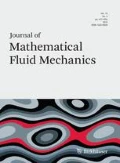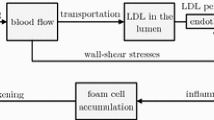Abstract
In this work we propose a mathematical and numerical model to describe the early stages of atherosclerotic plaque formation, which is based on the interaction of processes with different spatial and temporal scales. A fluid–structure interaction problem, used to describe the cardiovascular mechanics arising between blood and the artery wall, is coupled to a set of differential problems describing the evolution of solute concentrations. In order to manage the multiscale-in-space nature of the involved processes, we propose a suitable numerical strategy based on the splitting and sequential solution of the coupled problem. We present some preliminary numerical results and investigate the effects of geometry, model parameters and coupling strategy on plaque growth.










Similar content being viewed by others
Notes
According to the following definition of TAWSS, this average is intended with respect to the fast time variable t, i.e. along a heartbeat, see Sect. 2.4 for its definition
To further simplify the notation, we omit symbol \(\,\,\widehat{}\,\,\) for the Lagrangian variables when they are arguments.
Here we are using a local-in-time interval [0, T].
Note that TAWSS depends also on space, i.e., \(TAWSS=TAWSS(\tau ,{\varvec{x}}).\)
References
Arzani, A.: Coronary artery plaque growth: a two-way coupled shear stress-driven model. Int. J. Numer. Methods Biomed. Eng. 36, e3293 (2019)
Avgerinos, N., Neofytou, P.: Mathematical modelling and simulation of atherosclerosis formation and progress: a review. Ann. Biomed. Eng. 47, 1764–1785 (2019)
Brown, A., Teng, Z., Evans, P., Gillard, J., Samady, H., Bennett, M.: Role of biomechanical forces in the natural history of coronary atherosclerosis. Nat. Rev. Cardiol. 13, 210–220 (2016)
Calvez, V., Houot, J., Meunier, N., Raoult, A., Rusnakova, G.: Mathematical and numerical modeling of early atherosclerotic lesions. ESAIM: Proc. 30, 1–14 (2010)
Caro, C., Fitz-Gerald, J., Schroter, R.: Arterial wall shear and distribution of early atheroma in man. Nature 223, 1159–1160 (1969)
Chalmers, A., Cohen, A., Bursill, C., Myerscough, M.: Bifurcation and dynamics in a mathematical model of early atherosclerosis: how acute inflammation drives lesion development. J. Math. Biol. 71, 1451–1480 (2015)
Chappell, D., Varner, S., Nerem, R., Medford, R., Alexander, R.: Oscillatory shear stress stimulates adhesion molecule expression in cultured human endothelium. Circ. Res. 82, 532–539 (1998)
Chatzizisis, Y., Coşkun, A., Jonas, M., Edelman, E., Feldman, C., Stone, P.: Role of endothelial shear stress in the natural history of coronary atherosclerosis and vascular remodeling: molecular, cellular, and vascular behavior. J. Am. Coll. Cardiol. 49, 2379–2393 (2007)
Chiu, J.-J., Usami, S., Chien, S.: Vascular endothelial responses to altered shear stress: pathologic implications for atherosclerosis. Ann. Med. 41, 19–28 (2008)
Cicha, I., Goppelt-Struebe, M., Yilmaz, A., Daniel, W., Garlichs, C.: Endothelial dysfunction and monocyte recruitment in cells exposed to non-uniform shear stress. Clin. Hemorheol. Microcirc. 39, 113–119 (2008)
Cilla, M., Peña, E., Martínez, M.: Mathematical modelling of atheroma plaque formation and development in coronary arteries. J. R. Soc. Interface R. Soc. 11, 20130866 (2014)
Corti, A., Chiastra, C., Colombo, M., Garbey, M., Migliavacca, F., Casarin, S.: A fully coupled computational fluid dynamics-agent-based model of atherosclerotic plaque development: multiscale modeling framework and parameter sensitivity analysis. Comput. Biol. Med. 118, 103623 (2020)
Crosetto, P., Deparis, S., Fourestey, G., Quarteroni, A.: Parallel algorithms for fluid-structure interaction problems in haemodynamics. SIAM J. Sci. Comput. 33, 1598–1622 (2011)
Cunningham, K., Gotlieb, A.: The role of shear stress in the pathogenesis of atherosclerosis. Lab. Investig. J. Tech. Methods Pathol. 85, 9–23 (2005)
Deparis, S., Forti, D., Grandperrin, G., Quarteroni, A.: Facsi: A block parallel preconditioner for fluid-structure interaction in hemodynamics. J. Comput. Phys. 327, 700–718 (2016)
Di. Tomaso, G., Diaz-Zuccarini, V., Pichardo-Almarza, C.: A multiscale model of atherosclerotic plaque formation at its early stage. IEEE Trans. Bio-med. Eng. 58, 3460–3463 (2011)
Donea, J., Giuliani, S., Halleux, J.: An arbitrary Lagrangian–Eulerian finite element method for transient dynamic fluid-structure interactions. Comput. Methods Appl. Mech. Eng. 33, 689–723 (1982)
Faxon, D., Fuster, V., Libby, P., Beckman, J., Hiatt, W., Thompson, R., Topper, J., Annex, B., Rundback, J., Fabunmi, R., Robertson, R., Loscalzo, J.: Atherosclerotic vascular disease conference: writing group III: pathophysiology. Circulation 109, 2617–2625 (2004)
Fernández, M., Gerbeau, J., Grandmont, C.: A projection semi-implicit scheme for the coupling of an elastic structure with an incompressible fluid. Int. J. Numer. Methods Eng. 69(4), 794–821 (2007)
Figueroa, C., Baek, S., Taylor, C., Humphrey, J.: A computational framework for fluid-solid-growth modeling in cardiovascular simulations. Comput. Methods Appl. Mech. Eng. 198, 3583–3602 (2009)
González Montero, J., Valls, N., Brito, R., Rodrigo, R.: Essential hypertension and oxidative stress: new insights. World J. Cardiol. 6, 353–366 (2014)
Grundy, S.M., Stone, N.J., Bailey, A.L., Beam, C., Birtcher, K.K., Blumenthal, R.S., Braun, L.T., de Ferranti, S., Faiella-Tommasino, J., Forman, D.E., Goldberg, R., Heidenreich, P.A., Hlatky, M.A., Jones, D.W., Lloyd-Jones, D., Lopez-Pajares, N., Ndumele, C.E., Orringer, C.E., Peralta, C.A., Saseen, J.J., Smith, S.C., Sperling, L., Virani, S.S., Yeboah, J.: 2018 aha/acc/aacvpr/aapa/abc/acpm/ada/ags/apha/aspc/nla/pcna guideline on the management of blood cholesterol: Executive summary: A report of the american college of cardiology/american heart association task force on clinical practice guidelines. J. Am. Coll. Cardiol. 73(24), 3168–3209 (2019)
Hao, W., Friedman, A.: The LDL–HDL profile determines the risk of atherosclerosis: a mathematical model. PLoS ONE 9, e90497 (2014)
Herrmann, R., Malinauskas, R., Truskey, G.: Characterization of sites with elevated LDL permeability at intercostal, celiac, and iliac branches of the normal rabbit aorta. Arterioscler. Thromb. J. Vasc. Biol. Am. Heart Assoc. 14, 313–323 (1994)
Hirt, C., Amsden, A., Cook, J.: An arbitrary Lagrangian–Eulerian computing method for all flow speeds. J. Comput. Phys. 14, 227–253 (1974)
Hwang, J., Saha, A., Boo, Y.C., Sorescu, G., Mcnally, J., Holland, S., Dikalov, S., Giddens, D., Griendling, K., Harrison, D., Jo, H.: Oscillatory shear stress stimulates endothelial production of o 2- from p47phox-dependent NAD(P)H oxidases, leading to monocyte adhesion. J. Biol. Chem. 278, 47291–47298 (2003)
Kiechl, S., Willeit, J.: The natural course of atherosclerosis: part I: incidence and progression. Arterioscler. Thromb. Vasc. Biol. 19, 1484–1490 (1999)
Ku, D., Giddens, D., Zarins, C., Glagov, S.: Pulsatile flow and atherosclerosis in the human carotid bifurcation—positive correlation between plaque location and low and oscillating shear-stress. Arteriosclerosis (Dallas, Tex.) 5, 293–302 (1985)
Kwak, B., Bäck, M., Bochaton-Piallat, M.-L., Caligiuri, G., Daemen, M., Davies, P., Hoefer, I., Holvoet, P., Jo, H., Krams, R., Lehoux, S., Monaco, C., Steffens, S., Virmani, R., Weber, C., Wentzel, J., Evans, P.: Biomechanical factors in atherosclerosis: mechanisms and clinical implications. Eur. Heart J. 35, 3013–3020 (2014)
Libby, P.: Inflammation in atherosclerosis. Arterioscler. Thromb. Vasc. Biol. 32, 2045–2051 (2012)
Liu, B., Tang, D.: Computer simulations of atherosclerotic plaque growth in coronary arteries. Mol. Cell. Biomech. MCB 7, 193–202 (2010)
Nichols, W., O’Rourke, M., Vlachopoulos, C. (eds.): McDonald’s Blood Flow in Arteries. Hodder Arnold (2011)
Nixon, A., Gunel, M., Sumpio, B.: The critical role of hemodynamics in the development of cerebral vascular disease: a review. J. Neurosurg. 112, 1240–1253 (2009)
Nobile, F., Pozzoli, M., Vergara, C.: Time accurate partitioned algorithms for the solution of fluid-structure interaction problems in haemodynamics. Comput. Fluids 86, 470–482 (2013)
Nobile, F., Pozzoli, M., Vergara, C.: Inexact accurate partitioned algorithms for fluid-structure interaction problems with finite elasticity in haemodynamics. J. Comput. Phys. 273, 598–617 (2014)
Nobile, F., Vergara, C.: An effective fluid-structure interaction formulation for vascular dynamics by generalized robin conditions. SIAM J. Sci. Comput. 30, 731–763 (2008)
Parton, A., Mcgilligan, V., O’Kane, M., Baldrick, F., Watterson, S.: Computational modelling of atherosclerosis. Brief. Bioinform. 17, 562–575 (2015)
Pozzi, S., Vergara, C.: Mathematical and numerical models of atherosclerotic plaque progression in carotid arteries. In: Vermolen, F.J., Vuik, C. (eds.) Numerical Mathematics and Advanced Applications ENMATH 2019. Springer, Berlin (2021)
Ross, R.: Atherosclerosis-an inflammatory disease. Am. Heart J. 138, S419–S420 (1999)
Silva, T., Jäger, W., Neuss-Radu, M., Sequeira, A.: Modeling of the early stage of atherosclerosis with emphasis on the regulation of the endothelial permeability. J. Theor. Biol. 496, 110229 (2020)
Swim, E., Seshaiyer, P.: A nonconforming finite element method for fluid-structure interaction problems. Comput. Methods Appl. Mech. Eng. 195(17–18), 2088–2099 (2006)
Tarbell, J.: Mass transport in arteries and the localization of atherosclerosis. Annu. Rev. Biomed. Eng. 5, 79–118 (2003)
Thon, M., Hemmler, A., Glinzer, A., Mayr, M., Wildgruber, M., Zernecke-Madsen, A., Gee, M.: A multiphysics approach for modeling early atherosclerosis. Biomech. Model. Mechanobiol. 17, 617–644 (2017)
Traub, O., Berk, B.: Laminar shear stress: mechanisms by which endothelial cells transduce an atheroprotective force. Arterioscler. Thromb. Vasc. Biol. 18, 677–685 (1998)
Yang, Y., Jager, M., Neuss-Radu, W., Richter, T.: Mathematical modeling and simulation of the evolution of plaques in blood vessels. J. Math. Biol. 72, 973–996 (2015)
Zarins, C., Giddens, D., Bharadvaj, B., Sottiurai, V., Mabon, R., Glagov, S.: Carotid bifurcation atherosclerosis. Quantitative correlation of plaque localization with flow velocity profiles and wall shear stress. Circ. Res. 53, 502–514 (1981)
Zohdi, T., Holzapfel, G., Berger, S.: A phenomenological model for atherosclerotic plaque growth and rupture. J. Theor. Biol. 227, 437–443 (2004)
Author information
Authors and Affiliations
Corresponding author
Ethics declarations
Conflict of interest
The authors declares that they have no competing interests.
Additional information
Communicated by F. Gazzola.
Publisher's Note
Springer Nature remains neutral with regard to jurisdictional claims in published maps and institutional affiliations.
Rights and permissions
About this article
Cite this article
Pozzi, S., Redaelli, A., Vergara, C. et al. Mathematical Modeling and Numerical Simulation of Atherosclerotic Plaque Progression Based on Fluid-Structure Interaction. J. Math. Fluid Mech. 23, 74 (2021). https://doi.org/10.1007/s00021-021-00598-8
Accepted:
Published:
DOI: https://doi.org/10.1007/s00021-021-00598-8
Keywords
- Fluid–structure interaction
- Systems of partial differential equations
- Diffusion–reaction problems
- Wall shear stress
- Atherosclerosis
- Plaque progression




